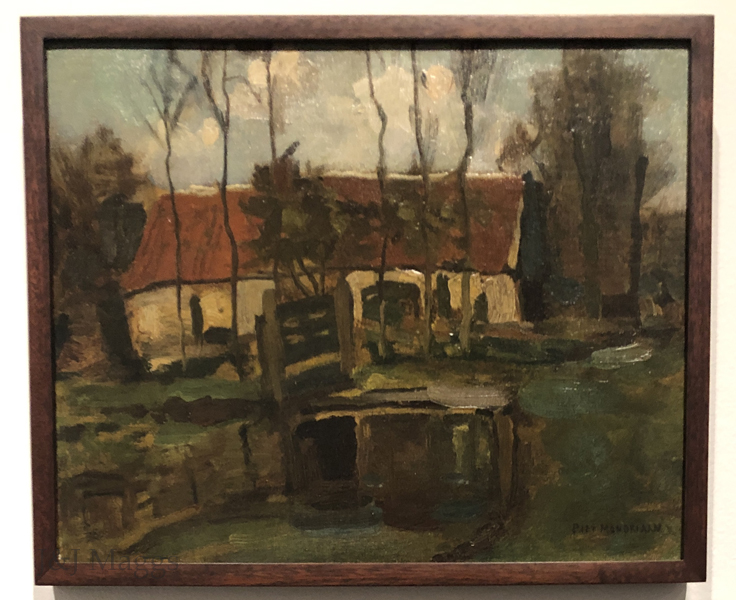Jan & John Maggs
Antiques and Art
Rediscovering Piet Mondrian at Boston's MFA
~ ~ ~ ~ ~ ~ ~ ~ ~ ~ ~ ~ ~ ~ ~ ~ ~ ~ ~ ~ ~ ~ ~ ~ ~ ~ ~ ~ ~ ~ ~ ~ ~
Last month we visited the Museum of Fine Arts in Boston, ostensibly to view the acclaimed John Singer Sargent exhibition, Fashioned by Sargent. Ironically, it was another exhibition that captured our attention. Mondrian: Foundations, a small but brilliantly conceived and produced show, featured several works painted long before the evolution of the style by which Mondrian is now universally known. We were struck by his kinship with Dutch painters of the Golden Age and of the Hague School, probably our two favorite areas in Western art, and how his development was influenced strongly by other important lights in the art world. We hope you'll enjoy this sampling as much as we enjoyed the exhibition.
~ ~ ~ ~ ~ ~ ~ ~ ~ ~ ~ ~ ~ ~ ~ ~ ~ ~ ~ ~ ~ ~ ~ ~ ~ ~ ~ ~ ~ ~ ~ ~ ~
Mondriaan was born in the Netherlands in 1872. His father was an art teacher, and his uncle Frits was a student of the Hague School artist Willem Maris. Frits and young Pieter often painted together, and he exerted a strong influence on Mondrian's early work. Here are a few examples from this time that were included in the exhibition.
~ ~ ~ ~ ~ ~ ~ ~ ~ ~ ~ ~ ~ ~ ~ ~ ~ ~ ~ ~ ~ ~ ~ ~ ~ ~ ~ ~ ~ ~ ~ ~ ~

Large Ponds in the Hague Forest (1887)
The earliest known work by Mondrian, aged 15 at the time
~ ~ ~ ~ ~ ~ ~ ~ ~ ~ ~ ~ ~ ~ ~ ~ ~ ~ ~ ~ ~ ~ ~ ~ ~ ~ ~ ~ ~ ~ ~ ~ ~

Post Mill at Heeswijk, Side View (1904)
One of several scenes of the Dutch countryside featured in the show
~ ~ ~ ~ ~ ~ ~ ~ ~ ~ ~ ~ ~ ~ ~ ~ ~ ~ ~ ~ ~ ~ ~ ~ ~ ~ ~ ~ ~ ~ ~ ~ ~

Farm Building with White Side Facade (ca. 1905)
~ ~ ~ ~ ~ ~ ~ ~ ~ ~ ~ ~ ~ ~ ~ ~ ~ ~ ~ ~ ~ ~ ~ ~ ~ ~ ~ ~ ~ ~ ~ ~ ~

Gabled Farmhouse Facade with Tree, Fence, and Gateposts in Front (c. 1905)
~ ~ ~ ~ ~ ~ ~ ~ ~ ~ ~ ~ ~ ~ ~ ~ ~ ~ ~ ~ ~ ~ ~ ~ ~ ~ ~ ~ ~ ~ ~ ~ ~
Mondrian moved to Paris in 1911 and became active in the circle of cubist painters that included Pablo Picasso and Georges Braque. The next two works, described by Mondrian as "more or less pictorial", are from this period (1912 - 1917).
~ ~ ~ ~ ~ ~ ~ ~ ~ ~ ~ ~ ~ ~ ~ ~ ~ ~ ~ ~ ~ ~ ~ ~ ~ ~ ~ ~ ~ ~ ~ ~ ~

Apple Tree (c 1912)
~ ~ ~ ~ ~ ~ ~ ~ ~ ~ ~ ~ ~ ~ ~ ~ ~ ~ ~ ~ ~ ~ ~ ~ ~ ~ ~ ~ ~ ~ ~ ~ ~

Self-Portrait, 1911
~ ~ ~ ~ ~ ~ ~ ~ ~ ~ ~ ~ ~ ~ ~ ~ ~ ~ ~ ~ ~ ~ ~ ~ ~ ~ ~ ~ ~ ~ ~ ~ ~
Mondrian's signature style began to develop when he returned to Paris after World War I. The style by which he is best known today is the result of his evolution from naturalism through cubism, and finally the refinement of abstraction without the "pictorial" aspects of the earlier styles.
~ ~ ~ ~ ~ ~ ~ ~ ~ ~ ~ ~ ~ ~ ~ ~ ~ ~ ~ ~ ~ ~ ~ ~ ~ ~ ~ ~ ~ ~ ~ ~ ~

Composition with Blue, Yellow, and Red (1927)
~ ~ ~ ~ ~ ~ ~ ~ ~ ~ ~ ~ ~ ~ ~ ~ ~ ~ ~ ~ ~ ~ ~ ~ ~ ~ ~ ~ ~ ~ ~ ~ ~
Click HERE to visit the J&J Maggs Antiques home page.